Barcelona is a wonderful place to visit. Architecture is stunning, history seeps out of every corner and we have the sea and the mountains on our doorstep. However, lately, the prices have risen steeply for accommodation and sightseeing. Don’t panic! It is still possible to visit us without breaking the bank. I have prepared The Ultimate Guide for Free Things to do in Barcelona which will keep you entertained for the entire trip. Sometimes these attractions do have a fee but there are certain times when they won’t cost you a penny. It doesn’t matter if you are a history buff, a foodie, a shopaholic or a beach lover. There is a bit for everyone. Hope it helps with your planning.
This post was updated in January 2024
INDEX
- Top 15 FREE things to do in Barcelona
- 1- Explore the Roman remains of Barcino
- 2- Enjoy the views from a hilltop
- 3- Take a Free Walking Tour with a local company
- 4- Culture yourself out at a museum
- 5- Marvel at the Magic Fountain show
- 6- Admire the Catalan Art Nouveau facades
- 7- Wander around a local food market
- 8- Get religious at Gothic churches
- 9- Discover the Street Art of the city
- 10- Relax at one of the city beaches
- 11- Travel to the past at El Born Cultural & Memorial Centre
- 12- Find bargains at Els Encants flea market
- 13- Have a picnic at Parc de la Ciutadella
- 14- Visit the monumental cemeteries
- 15- Join the locals at the city festivals
Top 15 FREE things to do in Barcelona
1- Explore the Roman remains of Barcino
Being built by the Romans, you can expect to find their remains scattered around. Sometimes these ruins are right in front of you and other times… well, you have to find those hidden places.
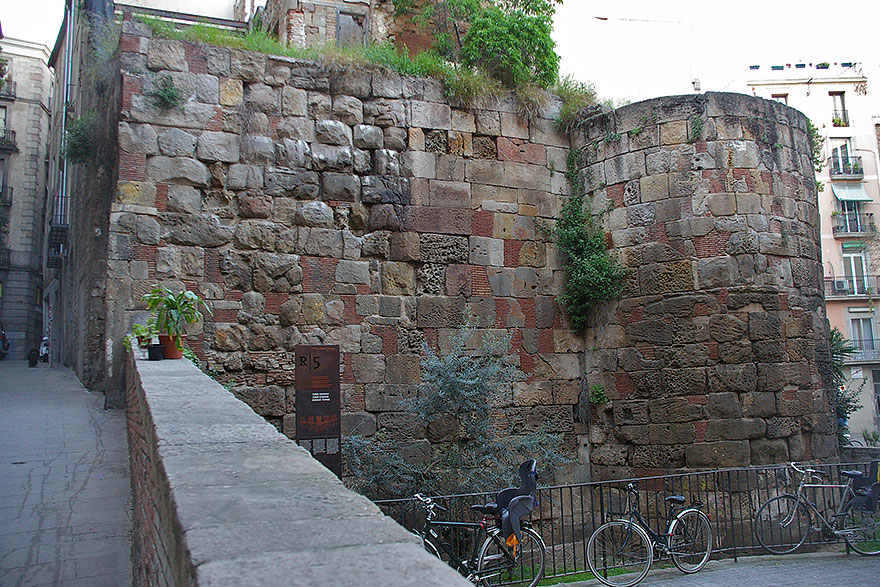
These are some of the free sites I recommend to help understand the origins of the city:
Roman city wall
You can actually walk around the whole perimeter of the Roman city following explanatory panels. The most spectacular parts are the city entrances at Plaça Nova at Pati Llimona Civic Center and the wall and towers at Plaça Ramon Berenguer. However, the wall is embedded all over the city. You can find it inside the buildings, like at the Mercer Hotel or in other houses along Avinyó Street.
Roman aqueduct
At Plaça del Vuit de Març, the remains of the original aqueduct discovered in the 1980s are on view attached to the walls. Nearby, inside Casa de l’Ardiaca, not only can you enjoy for free its beautiful patio but you can also see the end of the line with the deposit that distributed water to the whole city.
Roman Domus
There are two Roman houses that recently opened to the public: The Domus of Sant Honorat at Carrer de la Fruita, 2 and the Domus of Avinyó at Carrer d’Avinyó, 15. The highlight of the house at Avinyó Street is the well-preserved wall murals. Both have a free entrance on the first Sunday of the month from 10 am to 2 pm.
Roman necropolis
Outside the perimeter of the Roman city, at Plaça de la Vila de Madrid, an unexpected burial site was uncovered in the 1950s. A few meters under street level you can see the funeral monuments lined up on both sides of the old road that led to Barcino.
Temple of Augustus
Sure you are not expecting to find the remains of a 2,000-year-old temple stuck inside a house. But anything is possible in Barcelona. At the highest point of the Roman City (Carrer del Paradís, 10), after entering the house, four impressive columns are waiting for you. This is what is left of the original temple dedicated to Emperor Augustus, the founder of the city.
City History Museum
This is the main place to admire and learn about the legacy of the Romans in Barcelona. The excavations of the 1930s and 1960s uncovered a very interesting part of Barcino, including baths, alleys, houses and wine cellars. It is a fascinating journey in time that I strongly recommend. The museum has a free entrance every Sunday from 3 pm to 8 pm and all day on the first Sunday of the month.
OUR LOCAL TIP: I used to recommend having delicious chocolate with churros at a traditional cafe where you could enjoy your treat beside the late 3rd century AD Roman wall. Unfortunately, this cafe has closed down now and a Christmas caganer figurines shop has opened there instead. But don’t worry, there are many other places in the city to try chocolate and churros. My favourite is Granja Viader.
2- Enjoy the views from a hilltop
Barcelona is located between the sea and the mountains with Collserola Hill as the perfect backdrop. So, finding a place to climb up for a view is never a problem.
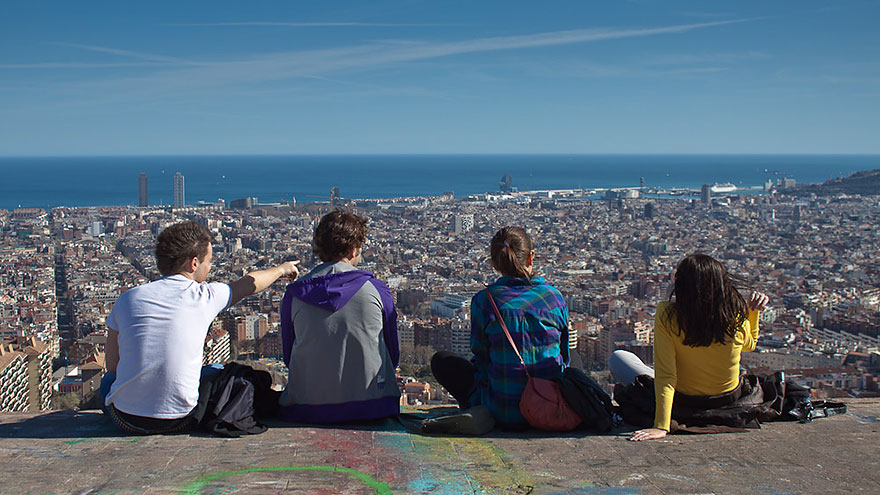
These are some of my favourite free sites to get that perfect panoramic photo:
Montjuïc Castle
An icon of Barcelona and a great place to take a look at the city and the port. Not only do you have fantastic views of the whole area but there is also a pleasant walk around the perimeter of the castle. A great plan is to get there by metro+funicular and go down on foot by Mirador de l’Alcalde, overlooking the city.
Tibidabo
The name comes from one of the temptations of Christ in the Bible. This time, Barcelona becomes the temptation! The 1905 amusement park and the Church of the Sacred Heart are both located at the top and, on a clear day, it is possible to see as far as Montserrat.
Turó de la Rovira
If you want the perfect photo of Barcelona with the Mediterranean as a backdrop, this is the place. The platforms to relax on are the remains of an anti-aircraft battery from the Spanish Civil War. Just try to avoid the sunset when, unfortunately in later years, the place seems to get too packed and noisy.
MNAC terraces
Maybe the views are not as high as in other places but the terrace in front of Catalonia’s National Art Museum is always a very picturesque viewpoint. A visit to the museum with a look at the Magic Fountain show makes it for a perfect evening in Barcelona.
Park Güell
The park is divided into two areas: The Forest Zone and the Monumental Zone. Although I highly recommend visiting the Monumental Zone, the Forest Zone is still free and offers nice viewpoints overlooking Barcelona. Until recently, you could also enter the Monumental Zone for free if you arrived before the ticket office opening time at 9:30 am. However, now the timetable from 7 am to 9:30 am and from 6 pm to 10 pm is only reserved for locals. Nothing is mentioned about entry before 7 am.
OUR LOCAL TIP: After a walk around Montjuïc Castle, head towards Mirador del Migdia (a viewpoint on the other side) and end the evening with a drink in the secret cafe beside it. On summer nights there are even free concerts in the garden.
3- Take a Free Walking Tour with a local company
Walking is the best way to see Barcelona and joining a local Free Walking Tour will help you understand a lot better what you are seeing. Runner Bean Tours offers, not one, but two different Free Tours every day, rain or shine. Both tours start at Plaça Reial at 11 am and 4.30 pm (in summer) and 11 am (in winter) and last for approximately 2.5 hours. Numbers are limited so reservations are recommended although not strictly necessary. If you haven’t booked, arrive 20 minutes early to secure a space on the tour of your choice.
Gothic Quarter Free Walking Tour
This is the best way to understand the history, traditions and legends of the city. Exploring the nooks and crannies of the medieval Gothic Quarter with a knowledgeable guide brings it to life. On this walking tour, you will see the highlights of the area but also the hidden spots, almost impossible to find on your own.
Gaudí Free Tour
This is a great way to introduce yourself to the world of Antoni Gaudí and discover 4 of his masterpieces. A voyage into the peak of the Catalan Art Nouveau movement of the past century and its most famous architect where the guide will shine a new light into Gaudí’s life and his buildings.
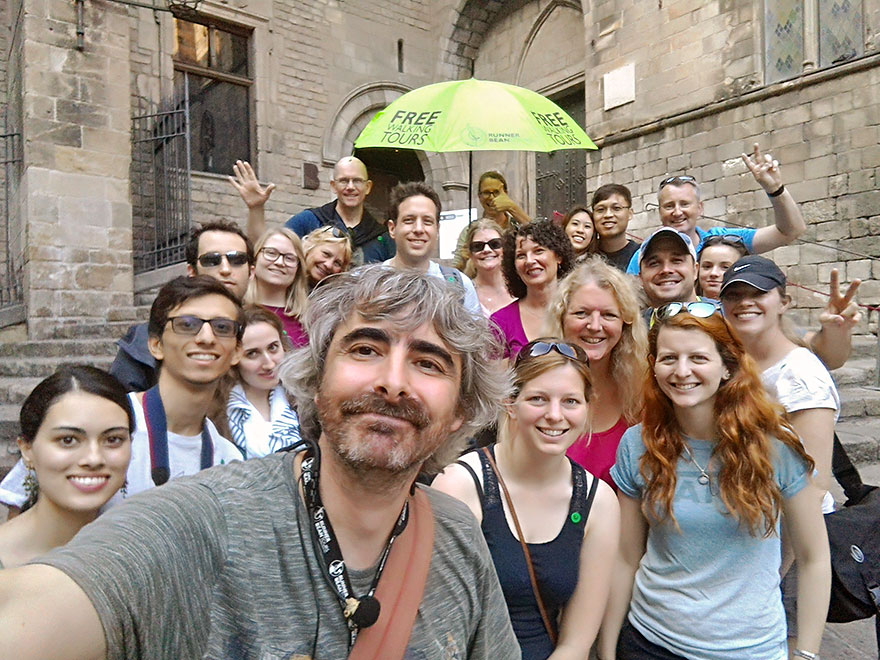
Nowadays, there are many companies offering donation-based tours in Barcelona but Runner Bean Tours are the pioneers in the city. Ann-Marie, myself and a handful of local guides have been offering these walks since 2010 and we love every minute of it. We are a local family-owned company with tours only in Barcelona. We believe this is the way to go as it creates that personal touch that makes the experience unforgettable. But don’t take our word for it. Thousands of happy travellers think so too and you can check all the online reviews!
OUR LOCAL TIP: Try to join the tours at the beginning of your visit. Firstly, it will help you understand Barcelona a lot better and this will be quite helpful for the rest of your stay. And secondly, the guides can give you plenty of recommendations on attractions to visit, places to eat, etc that you can use during your stay.
4- Culture yourself out at a museum
With a few exceptions, museums in Barcelona are quite pricey. However, most of the public museums do offer a free entrance on the first Sunday of each month and every Sunday after 3 pm. Please check with each one as the dates and times vary from one to the other.
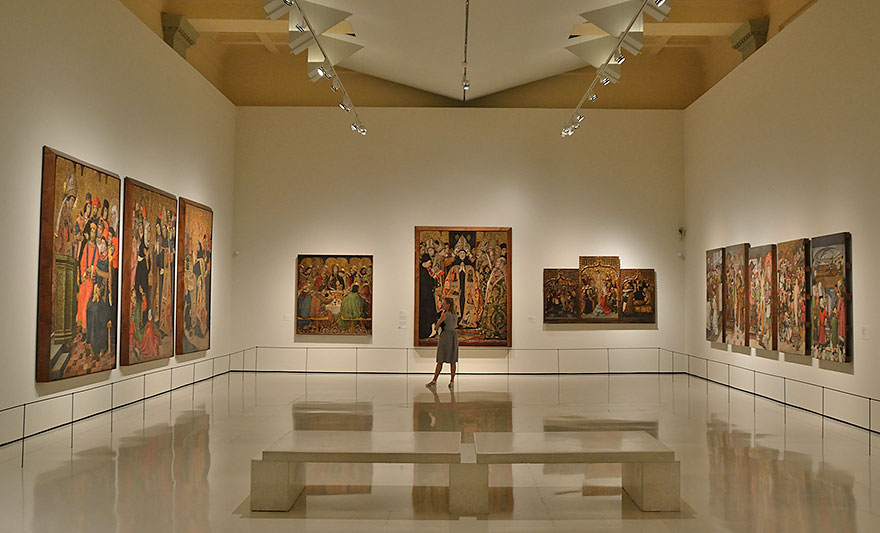
These are some of the most popular museums with their free opening times:
Catalonia’s National Art Museum (MNAC)
By far, the best Art collection in Barcelona and one of the best in Europe for Medieval Art. Free every Saturday from 3 pm and the first Sunday of the month until closing time (3 pm).
Picasso Museum
A fine collection of the artist’s early work and some of his interpretations of Velazquez’s Las Meninas. Free every Thursday from 4 pm to 7 pm and the first Sunday of the month (online booking required. Tickets are only available 4 days before the date).
Frederic Marès Museum
It holds this sculptor’s private collection. Don’t miss the fascinating top floor displaying every object imaginable. Free every Sunday from 3 pm and the first Sunday of the month.
City History Museum (MUHBA)
The highlight is the Roman remains of Barcino five metres under street level. A must for any Roman history or archaeology enthusiast. Free every Sunday from 3 pm and the first Sunday of the month.
Maritime Museum
Located in an old medieval shipyard, the building is a museum in itself. The highlight is the replica of a 16th-century Spanish galleon. Free every Sunday from 3 pm.
Barcelona Design Museum
A new addition to the city, this modern building holds an interesting collection as well as travelling exhibitions. Free every Sunday from 3 pm and the first Sunday of the month.
Natural History Museum (Museu Blau)
A must for children and adults alike. The temporary exhibitions are usually very interesting. Free every Sunday from 3 pm and the first Sunday of the month.
Most public museums also offer free entrance on our patron saint’s festivities: Santa Eulàlia (12th February) and La Mercè (24th September). May 18th is the International Day of the Museums so you can visit them all free of charge. Related to this event, on Saturday closest to that date, Barcelona celebrates The Night of the Museums, a wonderful activity for everyone where museums all over the city throw open their doors from 7 pm to 1 am with music, theatre, dance… you name it. A very special night indeed.
OUR LOCAL TIP: It is possible to visit our wonderful Town Hall for free every Sunday from 10 am to 2 pm. You can join a free guided visit in English (10 am), Spanish (11 am & 12 pm) and Catalan (10:30 am, 11.30 am & 12.30 pm) or just roam around on your own. The highlight is the Saló de Cent, the main medieval room that will take your breath away. You can usually even see weddings taking place there on weekends.
5- Marvel at the Magic Fountain show
The Magic Fountain is currently not running due to the drought in Barcelona.
What better thing to do for free in Barcelona than enjoy an outdoor light and music show at night? This is exactly what the Magic Fountain of Montjuïc offers. Built for the International Exhibition of 1929, this show has been entertaining Barcelonans and visitors alike for almost 100 years. If you are here in September during La Mercè Festival, don’t miss the closing event with the fountain, music and fireworks synchronized together for a grand finale.
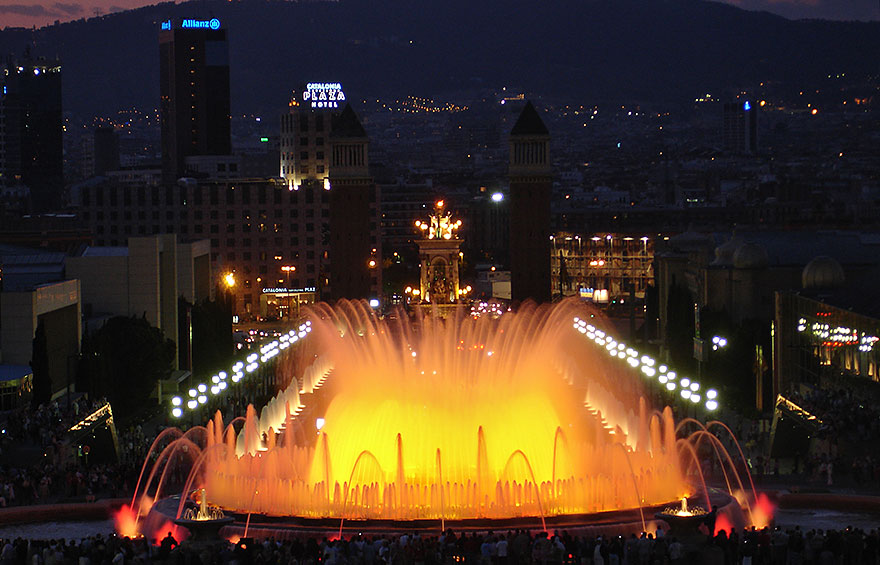
The timetable for the shows varies depending on the time of the year. It also closes for maintenance for nearly two months in January and February. If you are visiting at that time, the area is still worth checking out but maybe during the day. You can see the times when the Magic Fountain will operate here: Montjuïc’s Magic Fountain show times.
Just one word of warning: with so many people concentrating on the show and this being at night, there are always one or two pickpockets around. Nothing to worry about though. Just keep your belongings in front of you and gawp at the fountain!
OUR LOCAL TIP: Be sure you arrive at twilight or later to enjoy the show to its full extent. In the summer months, it gets dark quite late so, if you arrive too early, you might miss the wonderful colours that can only be seen at night time.
6- Admire the Catalan Art Nouveau facades
There is an area in Barcelona called Quadrat d’or (Golden Quarter) that includes one of the biggest concentrations of Art Nouveau buildings in the world. I am sure you have already heard of Casa Batlló and La Pedrera, Antoni Gaudí’s famous houses at Passeig de Gràcia. It is even possible that you know about other architects of the era like Doménech i Montaner or Puig i Cadafalch (two of the houses beside Casa Batlló were designed by them). But Barcelona’s Golden Quarter is much more than this. There are dozens of marvellous buildings dotted all over the place in the area between Plaça Catalunya, Carrer Aribau, Avinguda Diagonal and Passeig de Sant Joan.
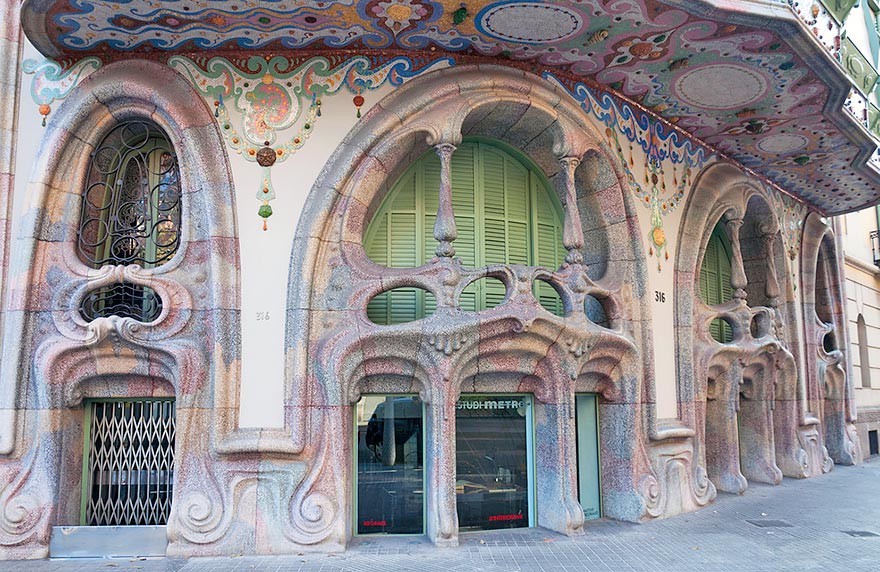
The Catalan bourgeoisie of the late 19th and early 20th century commissioned all these architects to build their over-the-top mansions and now we can all enjoy this open-air museum for free. We see some of these buildings on our Gaudí Free Tour but there is a lot more to explore. Enter a world of curved shapes, floral designs and stained-glass paradise!
I have prepared this Walking Route Map so you can check them all out. If you don’t have time to see them all, be sure that at least you don’t miss the 3 houses at the Block Of Discord (Casa Batlló, Casa Amatller and Casa Lleó i Morera), Palau del Baró de Quadras (don’t forget to go inside the doorway), Casa Milà (without doubt, Gaudí’s masterpiece), Casa de les Punxes (like a fairytale medieval castle) and Casa Comalat (the back façade at Còrsega street is even more spectacular than the front one).
OUR LOCAL TIP: Don’t stick only to the facades of the houses. Look out for the small details. You can enter some of these beautiful doorways to admire perhaps a 100-year-old lift, pharmacies with intricately carved woodwork or old bakeries with iron decorations and ceramic tiles that will take your breath away. All done in the Catalan Art Nouveau style of the time.
7- Wander around a local food market
One of the things that make Barcelona so special is that neighbourhood feeling. If you go to Sant Andreu, Poble Nou or Gràcia, just to name a few, you will feel like you are in a different city. Each of these has its own food market for locals to do their daily shopping. This is a great opportunity to check out the Catalan seasonal fresh delicacies.

If you are staying in an apartment, try to buy your groceries here. Firstly, you will be supporting a local family instead of a big supermarket chain, secondly, you can practice those words in Catalan which will make you feel very welcome. Also, let’s face it, it is a lot more fun!
Even if you are staying in a hotel, it is great to visit and see the buzz in a local Barcelona market. Just be sure that you buy something, even if it is a bit of ham to bring back home. Remember that this is a working market and not a museum. The vendors and your stomach will be very grateful. If you are gluten-intolerant, be sure you always ask “sense gluten, si us plau“.
OUR LOCAL TIP: Food markets won’t be open on Sundays and, usually, Saturday afternoons. If you are going to visit one, be sure you don’t go on a Monday as the fish stands will be closed. Fishermen, like most people, have their day off on Sunday so there will be no fresh fish the following morning.
8- Get religious at Gothic churches
There are 4 main Gothic basilicas in Barcelona and, although recently they have started to charge an entrance fee (funnily called donation), there are certain times when you can visit them for free. My advice is to see them all if you have time as each one is very special and has different things to offer.

These are the big 4 with their free opening times:
Cathedral of Saint Eulalia & the Holy Cross
The only Cathedral and still the centre of religious life in Barcelona. Don’t miss the atmospheric cloister, the crypt of Saint Eulàlia and the carved wooden chairs of the choir.
FREE OPENING TIMES (only for worship and prayer): Monday to Friday: 8.30 am to 12.30 pm & 6 pm to 7:30 pm / Saturday: 8.30 am to 12.30 pm & 5 pm to 8 pm / Sundays: 8:30 am to 1:45 pm & 5 pm to 8 pm. Other times: €14 (except Sundays when tourist visits are not allowed)
Basilica of Santa Maria del Mar
The masterpiece of the Catalan Gothic style in Barcelona and a much-loved church even for non-believers. The bareness of decoration after being burned during the Spanish Civil War makes it even more spectacular.
FREE OPENING TIMES: Monday to Thursday: 10 am to 1:30 pm & 5 pm to 8:30 pm / Friday to Sunday: 10 am to 8:30 pm. Tourist visit: €5
Basilica of Santa Maria del Pi
Another great example of Gothic architecture with a wonderful rose window. The 15th-century massive bell tower can easily be seen from La Rambla and is one of its most streaking features.
FREE OPENING TIMES (only for worship and prayer): Monday to Thursday: 10 am to 1 pm & 5 pm to 8 pm. Friday & Saturday: 9:30 am to 11 am & 6 pm to 8 pm. Sunday: 11 am to 1 pm. Other times: €5
Basilica of Sant Just i Pastor
The least known of the four but with many surprises waiting for you at the interior. These include recent archaeological finds underground and some of the quirkiest depictions of purgatory.
FREE OPENING TIMES: Monday, Wednesday, Thursday & Saturday: 11 am to 2 pm & 7 pm to 8:30 pm / Tuesday, Friday & Sunday: 10 am to 1 pm. Other times: closed
Remember that you can also pay a fee to see certain parts of these 4 masterpieces that are not open to the public on the free visit. This includes the fantastic views from the bell towers of Santa Maria del Pi and Sant Just, the museums displaying the treasures of each parish and an interesting walk on the rooftops of both the Cathedral and Santa Maria del Mar.
OUR LOCAL TIP: If you like Spanish classical guitar, there are fantastic evening concerts all year round at Santa Maria del Pi. They take place in a very intimate chapel beside the main entrance. I have attended a few of these myself and have always been awed by the performers. Check the schedule in case it coincides with your visit.
9- Discover the Street Art of the city
There is the Art of the museums and the Art of the streets, commonly known as graffiti or, to be more precise, Street Art. One of the best free things to do in Barcelona is to explore the streets looking for them. The Northern side of the Poble Nou neighbourhood is the Mecca for the big murals but little pieces of work in the form of sculptures crop out everywhere in the city.
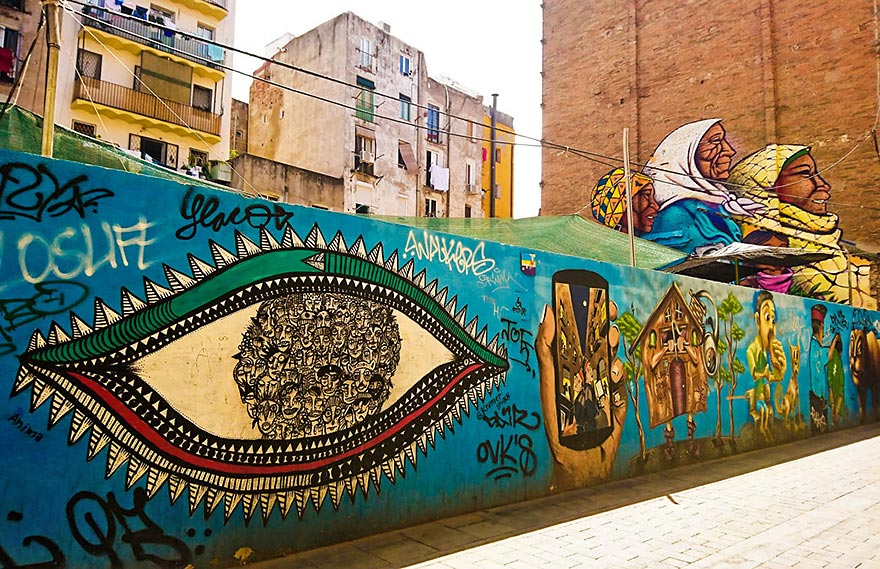
Although legally these decorations are prohibited in Barcelona, there are a few locations where the city council allows them and even provides a canvas. Most of them are located in Poble Nou but there is one in the very city centre at Jardins de les Tres Xemeneies, in Poble Sec. This open-air gallery of ever-changing walls is, of course, completely free of charge. But the good news is that the murals change every week so you can come back again and again and the experience will always be different.
OUR LOCAL TIP: If you want to get under the skin of the artists behind these creations, what’s better than calling the experts? I recommend joining Barcelona Street Style on one of their two free walking tours or the bike tour. They run every day exploring the neighbourhoods of El Born, Gòtic, Raval and Poble Nou.
10- Relax at one of the city beaches
Up until the 1992 Olympic Games, Barcelona’s beaches were dirty and unpleasant and had factories as a backdrop. Not a place the locals hung out, really. Nowadays it couldn’t be more different. The long stretch of coast from the W Hotel to the Besòs River becomes a haven for sun-seekers and coastal sports enthusiasts.
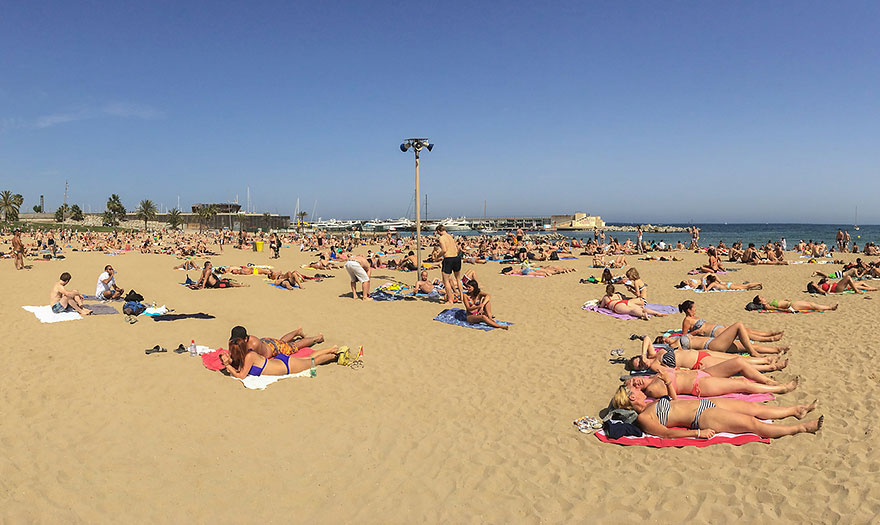
The summer is obviously the busiest period when all city beaches are packed. As you can imagine, the closest to the city centre (i.e.: Barceloneta) the more crowded and annoying it becomes (think of beer and massage offerings every minute). However, you will be surprised how quiet it can get on the beaches further away, especially if you visit during the week and outside the holiday months of July and August. One word of warning: always keep a good eye on your belongings as pickpockets are always on the alert.
OUR LOCAL TIP: If you want, not only a nice and relaxing beach day but also beautiful scenery, catch a train to the towns of Sitges or Sant Pol de Mar. The train is easy and takes only an hour or less.
11- Travel to the past at El Born Cultural & Memorial Centre
A recent addition to Barcelona’s heritage, El Born CCM is more than just a museum. Firstly, the cast-iron building is quite impressive (the old neighbourhood market from 1876). But, even more impressive, are the archaeological remains that show the daily life of Barcelona in 1714.
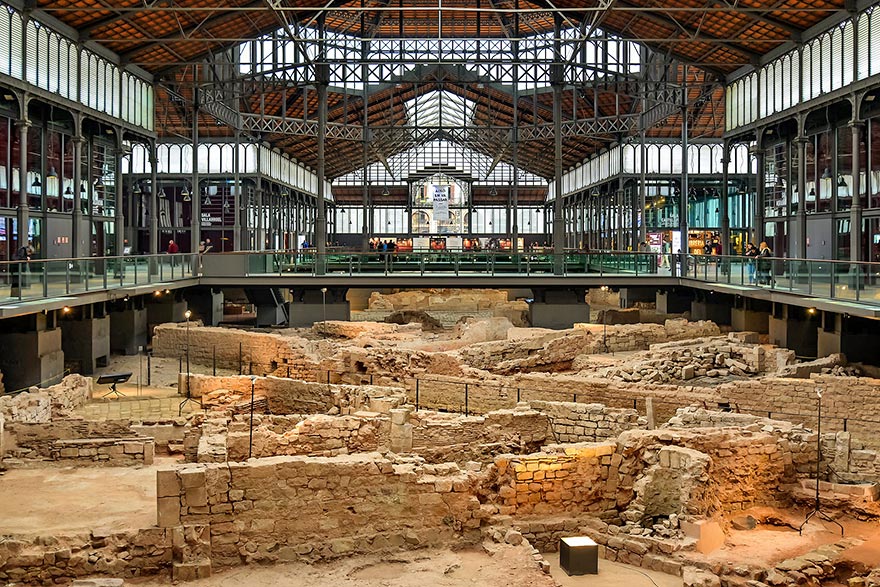
This place is unique in Europe. A large archaeological site in the middle of a city is not always easy to find. But, on top of that, we know who lived where and what they did thanks to the records kept in the archives. A time machine to take you back 300 years!
The centre also organises family activities and cultural itineraries as well as free temporary exhibitions.
OUR LOCAL TIP: You can enjoy the ruins from the platforms above with explanatory panels. However, to get deep into the history of the city, I highly recommend going deep down and taking the fascinating guided visit. They are offered in English during the high season at a reasonable price.
12- Find bargains at Els Encants flea market
This is one of the oldest running flea markets in Europe with its origins back in the 13th century. Nowadays, it includes about 500 vendors distributed on different floors. My favourite one is the ground floor where the antiques (and junk) are sold. Finding those jewels in between the thousands of articles is both an art and a challenge.

In 2013 a spectacular modern building was made to house it. The way the floors are distributed ensures that you don’t miss out on anything. To take a photo of the massive mirror ceiling showing all the vendor’s activity below is a classic.
The market opens on Mondays, Wednesdays, Fridays and Saturdays from 9 am to 8 pm. Take into account that some of the stands are only open during the weekend. However, there is something special on offer during the week. Keep reading.
OUR LOCAL TIP: On weekdays, from 7 am to 9 am, just before the market opens, there is an auction where the real bargains are. This is quite special as it is the only market in Europe that still works this way. Who knows what little treasure you can take back home!
13- Have a picnic at Parc de la Ciutadella
All big cities have a green area to do some jogging, have a picnic and chill out on sunny days. In Barcelona, Ciutadella Park fills up on weekends with people who are not so crazy about the beach and prefer a bit of greenery. On special dates, the park also serves as the perfect scenery for festivals (think food trucks and activities galore).
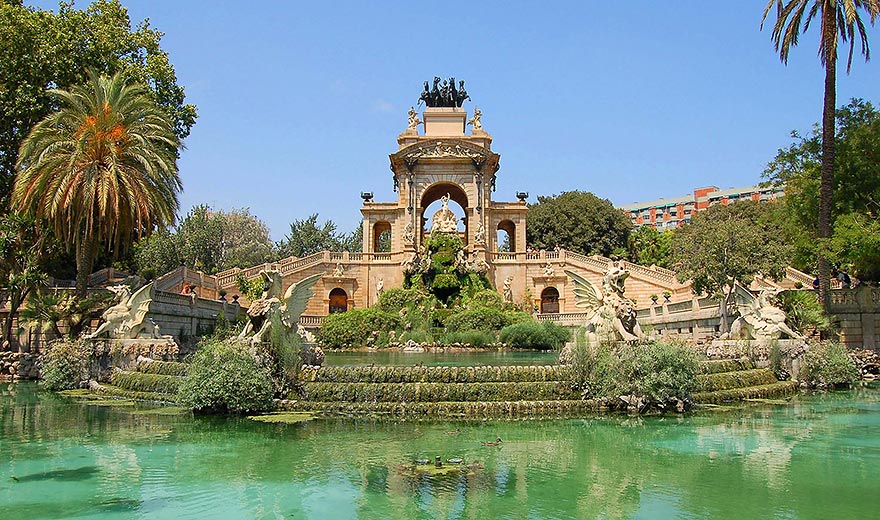
This was the site of the 18th-century fortress (hence the name “Ciutadella”, citadel) built to subdue the city after the War of Spanish Succession. 150 years later the fortress was demolished and this was the perfect location to house the Great Universal Exhibition of 1888. Once the World Fair was over, the city council turned it into the big public park that has remained so ever since. There are a few interesting places to explore including the remains of both the fortress and the Universal Exhibition:
Monumental waterfall
Venus at birth, scary gryphons, golden chariots… there is a place for all of them in this monumental waterfall that serves as the park’s icon. The outdoor cafe in front is the perfect place for refreshment on hot summer days.
Castle of the 3 Dragons
Designed by the famous Lluís Doménech i Montaner, it was built to house the World Fair’s restaurant. The Natural History Museum used to be here until it moved a few years ago so, at the moment, it is not open to the public.
The Hivernacle
This fantastic wrought iron structure is the tropical greenhouse built in the years before the Universal Exhibition. It has been recently reopened after being restored to its grandeur.
Catalan Parliament
Together with the chapel and the Governor’s Palace, this is one of the few reminders of the old citadel. Ironically, what once was the arsenal of the fortress, now houses the Parliament of Catalonia.
Barcelona Zoo
Although located outside the free area (there is an entrance fee), Barcelona’s zoo is also located here. Its most famous resident was Snowflake, the only albino gorilla known to date who passed away in 2003.
Arc de Triomf
Not in the park itself but a pleasant walk away is the monumental arch that served as the main entrance to the Universal Exhibition. The area between the arch and the park is commonplace for food fairs and free concerts.
OUR LOCAL TIP: If you are visiting Barcelona with children, this is a perfect place to spend a morning or an afternoon. The young ones will love the kid’s playground and the big mammoth statue. If you bring rackets you can even have a nice match on the public ping-pong tables to burn off all that energy!
14- Visit the monumental cemeteries
For the few funerary art enthusiasts out there, you are in luck. Barcelona boasts a few cemeteries worth taking a look at. The number of visitors is very low during the week so you can enjoy a stroll around these Cities of the Dead undisturbed. As you can imagine considering the amount of money that came into Barcelona during the 19th and early 20th centuries, the sculptural work is sometimes sublime.
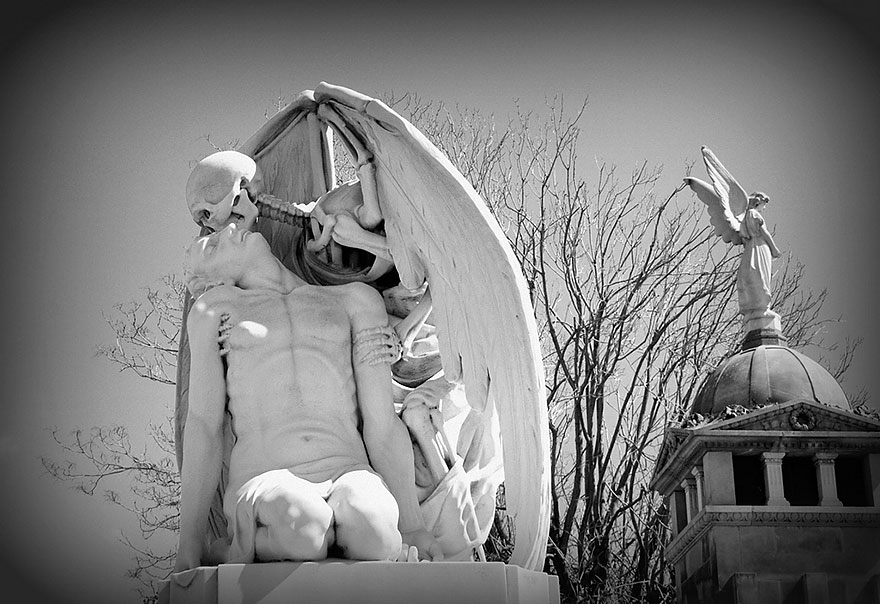
There are a few cemeteries in different areas of the city and the good news is that they offer free guided visits two Sundays a month. I highly recommend taking them if you understand Spanish or Catalan as they give fantastic background information on the different graves and people buried there. For the brave ones, they also organise candlelit night visits twice a year. These are the most spectacular graveyards that I recommend visiting:
Poble Nou Cemetery
The first modern graveyard in Barcelona was built in 1775 to stop the unhygienic burials in the city centre. The actual cemetery was rebuilt in 1819 after being destroyed in the war against the French. You come here for the beautiful 19th-century neoclassical architecture. Don’t miss the famous sculpture El Petó de la Mort (“The Kiss of Death”) and the grave of El Santet, with, literally, thousands of notes from devotees asking him for favours.
GUIDED TOURS: 1st Sunday of the month at 10.30 am (Catalan) and 3rd Sunday of the month at 10.30 am (Spanish). No reservation is required.
Montjuïc Cemetery
A massive area of Montjuïc Hill is taken by this incredible site overlooking the sea. The Catalan bourgeoisie not only hired the best Art Nouveau architects to build their mansions in the city but also to design their last resting places here. Don’t miss the zone reserved for the non-believers (the most important anarchist leaders are buried here) and El Fossar de la Pedrera, a strikingly sombre garden of remembrance for the victims of Franco’s repression after the Spanish Civil War.
GUIDED TOURS: 2nd Sunday of the month at 11:15 am (Catalan) and 4th Sunday of the month at 11:15 am (Spanish). No reservation is required.
OUR LOCAL TIP: Montjuïc Cemetery is not easy to reach on public transport (not impossible so don’t despair) but once you get there don’t forget to visit the amazing museum displaying the funeral horse-drawn hearses and carriages. It opens free of charge on Saturdays and Sundays from 10 am to 2 pm.
15- Join the locals at the city festivals
Barcelona and Catalonia are worldwide famous for their local festivals. Usually related to a patron saint, they crop up all year round in the different neighbourhoods. Two of the most spectacular ones are Festes de Gràcia in August and La Mercè Festival in September.
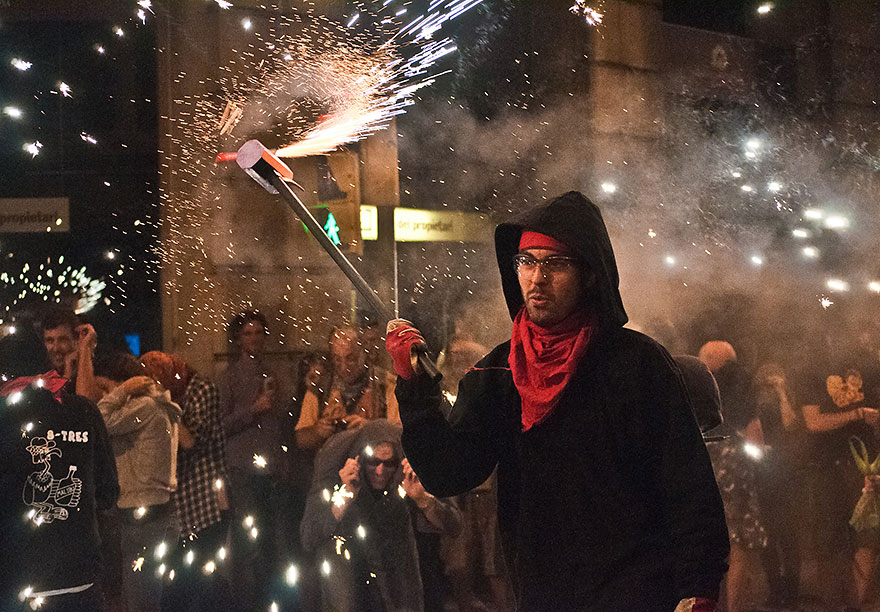
These are just some of the free attractions and activities that you might come across when you join the locals at the celebrations:
Human towers (“castells”)
World-famous Catalan human towers are an experience not to be missed. Up to 10 floors high, a brave child will climb to the top and complete the castle (“castell”). If you are lucky to be in the city for La Mercè Festival, the best groups will perform in front of the Town Hall on the Sunday that is closest to September 24th.
Giants and Beasts parades
A festival is never complete without taking out the giants! These papier-mâché dolls depicting historical figures or famous Barcelona characters come to life with their special dances. On the parades, the giants are sometimes accompanied by the beasts, but I will talk about them in the next point.
Fire runs (“correfocs”)
Definitely, one of the craziest experiences that you can have in Barcelona. Imagine beasts in the form of dragons and evil figures, put them together with a bunch of people dressed as devils and chasing you with giant fire sparklers, mix it all on a parade and you get correfoc. Don’t forget to cover yourself in non-flammable clothing!
Decorated streets
Some of the festivals include very imaginative street decorations using recycled materials. A street that you walk through every day suddenly turns into the set of a zombie movie or a modern Jurassic Park. You can see this in the neighbourhoods of Sants and, especially, Gràcia, where the quality of the decorations is taken to a whole new level.
Free music concerts
Music is a very important part of Barcelona’s life with some styles originating in this area (Catalan Rumba and Habaneras come to mind). So it is not strange that whenever there is a festival there is music. Rock, folk, flamenco, hip-hop, and World music, there is a bit for everyone and all for free.
Fireworks and light shows
Like everywhere in the world, whenever there is a celebration, there are fireworks. In Barcelona, we usually have them by the beach which could be great for all the photographers out there. A new addition is the light shows that are projected onto iconic buildings like the Town Hall, Casa Batlló or even Sagrada Familia.
OUR LOCAL TIP: No festival scheduled during your stay? Don’t worry, you can still taste a little of it by paying a visit to La Casa dels Entremesos. This small hidden museum has on display all the giants and beasts of the different neighbourhoods. A real hit with both children and adults. The museum is free but please leave a small donation to help keep this wonderful place alive. We visit it on our special Kids & Family Walking Tour.
I hope you enjoyed this comprehensive list of free things to do in Barcelona. The idea is to help plan your trip. Any suggestions are always more than welcome though. If you find something that you think deserves to be on the above list, please let me know in the comments below.
Also, for more local tips you can check the recommendations from our friends at Spotted By Locals and check our complete articles with Things to do in Barcelona and Barcelona at night activities.
Finally, if you are travelling around Spain, our friends at OGO Tours and Explora Malaga have created a great list of Free Things to Do in Madrid and Best Things to Do in Malaga for Free. Klara, from Prague Extravaganza, has also great recommendations for Free Things to Do in Prague. You would probably want to check them out.
Enjoy a free Barcelona!
Main photograph by Victoriano Javier Tornel García. Vector Art by www.vecteezy.com
Frequently Asked Questions To Enjoy Barcelona For Free
What are the best free outdoor attractions in Barcelona?
These are our recommended free outdoor attractions in Barcelona:
- Montjuïc Magic Fountain Show
- Free Walking Tour With A Local Guide
- Catalan Art Nouveau Façades
- Cemeteries Of Poblenou & Montjuïc
- Hilltop Panoramic Views
- Barcelona Beaches
What are the best free things to do in Barcelona on a rainy day?
These are the best things to do in Barcelona when it rains:
- Barcelona City Museums
- Gothic Churches And Cathedral
- Els Encants Flea Market
- El Born Cultural Centre
What are the best free cultural sites in Barcelona?
These are the best cultural sites in Barcelona for free:
- Free Walking Tour With A Local Guide
- Barcelona Roman Remains
- Gothic Churches And Cathedral
- Barcelona City Museums
- Local Traditions At Barcelona Festivals
What are the best free things to do in Barcelona with kids?
These are the best free things to do in Barcelona for families with kids:
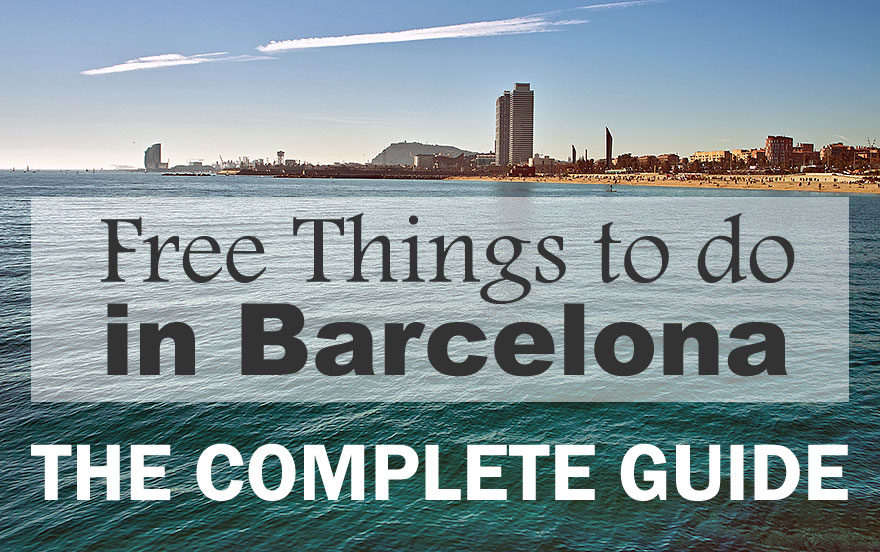
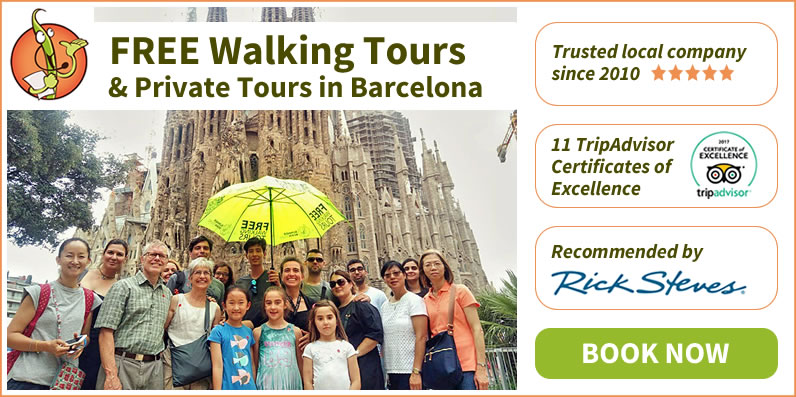









Hola, I have just booked a walk with you in September (10/9). I believe the next day is the Catalonia Day celebrations, I would love to see Castells and wondered if you have any suggestions for me to see something. I Arrive late on 9/9 and fly out on 14/9 again late. Gràcies
Catalonia’s National Day is indeed on September 11th. It is not much of a festival but a political affair with stands and flower offerings in the morning and a very big demonstration (peaceful) in the afternoon. However, you are in luck because there will be “castells” bang in the centre of Barcelona :-). This is the time and location:
Time: 11.30am
Location: Plaça Comercial
I hope you enjoy it!
Hello! I enjoyed your site and will book with you once in Barcelona. Do you have any recommendations of a good side trip of a few days from Barcelona in April? We will rent a car if needed, (and do not want to visit a big city like Madrid).
Thank you for your guidance!
Glad you enjoyed the advice on free things to do in Barcelona. We would love to take you on a waking tour during your visit 🙂
Regarding day excursions from Barcelona, there are a few options: You can visit Montserrat (beautiful mountain and monastery), spend a day in Girona (stunning medieval city) head to Tarragona (Roman history galore) or go to Sitges (beach town). There is easy public transportation for all of these places.
You can also take a day trip to the Pyrenees or Costa Brava although it is a bit far to do it as a day trip so I would stick to the other ones.
HI,
IM TRAVELLING FROM INDIA TO BARCELONA AND IM THERE FROM THE EVENING OF 9TH MARCH2019 TO 16TH OF MARCH 2019. WATCHING THE MATCH AT NOU CAMP ON THE VENING OF 9TH AND DOING SOME MORNING TRIPS THE REST OF THE DAYS. COULD YOU PLEASE SUGGEST SOME NIGHT TIME SIGHTSEEING FOR A FAMILY OF THREE( NO BAR HOPPING OR NIGHT CLUBS OR WINE TASTING) HAVE SEEN THE MAGIC FOUNTAIN TOUR AND NIGHT BUS TOUR AND SEGWAY NIGHT TOUR. CAN YOU KINDLY TELL ME YOUR PERSONAL RECOMMENDATIONS PLEASE AND IS THEFT A REAL PROBLEM AS ITS MADE OUT TO BE. I AM STAYING IN THE PLAZA DEL PAISOS.
THANK YOU IN ADVANCE AND HOPE HEAR FROM YOU SOON.
HAVE A GREAT DAY
I think that you will love the Magic Fountain ant Montjüic, specially if you are traveling with children. The timetable is on my list of Free Things to do in Barcelona above. You can also go to a classical guitar concert at Palau de la Musica which is always a nice way to see the interior of the building. Other options could be a escape room, a food tour or even the Segway tour that you mentioned (although, if you are going to be driving a Segway at night, be sure that the area is lit enough so you can see ;-).
Regarding safety, don’t worry, Barcelona is a very safe city in terms of violent crime. The only problem could be petty theft in the way of pickpockets (like in any other big European city that attracts tourists like London, Berlin or Rome) but, as long as you take the basic precautions, there is no reason to worry. Millions visit Barcelona every year without a single incident.
Have a lovely time in Barcelona!
hi
I am visiting at the end of this month/start of next month for a couple of days. Would you be able to suggest whether it is worth purchasing a hop-on-hop off bus ticket or getting the t10 ticket and walking to most places? I’m on a really tight budget and this is a surprise trip for my husband… he thinks we’re staying in the UK!
We will be there for 2 full days just about) and then a couple of hours the day of our trip back. I’m not that interested in seeing every single museum or attraction but wouldn’t mind seeing at least top 5 places in Barcelona.
I’d love to know your thoughts. Very much appreciated.
Thank you
The metro is very reliable in Barcelona and brings you to most places. I think that purchasing a metro pass is a much better idea than using he Hop-on Hop-off for traveling around.
I hope you enjoy our city. It’s a beautiful surprise for your husband! 🙂
Thank you! I might book on to one of the free walking tours. I’ve read great reviews. 🙂
No problem at all, Kam. It would be great to show you Barcelona if you join one of our Barcelona free tours.
We will be in Barcelona Dec. 7-14th. Are there any special concerts for Christmas? One at a cathedral would be preferred. Gracias!
You have Handel’s Messiah performed at L’Auditori and at Palau de la Musica. You can find more information here:
– Handel’s Messiah at the Auditori (December 13th, 14th & 15th)
– Handel’s Messiah at Palau de la Musica (December 10th)
These are obviously Christmas season typical concerts but you will have plenty of other concerts all over the city. You can check Barcelona Time Out Magazine or Atiza website.
We will be in Barcelona from Feb. 6-Feb. 16 during the Santa Eulalia festival. Do you know where I can find a schedule of events? We have booked a tour with you for the Saturday after we arrive!
The City Council won’t release the programme until a few days before the festival. My advice is to keep checking the official site of the festival where you will find all the activities. At the moment you will see the 2019 programme that can give you an idea of what to expect.
Thank you for all the information you have provided. We will be visiting Barcelona towards the end of March and i will definitely be booking one of your walking tours
Glad you found the info helpful, Diane. See you soon in Barcelona 🙂
This is very beautiful place and grate photograph. I like the post.
Thank you Amelia. I think it’s a very complete list of free things to do in Barcelona. Glad you found it helpful.
Amazing blog, please keep on writing blogs like this they are really interesting and well written.
Thanks a lot. I am glad it helped you find some free things to do in Barcelona. It also encourages me to write more helpful articles 🙂
Hi I am visiting Barcelona in March for the first time, what would you recommend to do for 5 days?
Hi Sia,
You won’t be short of things to do and see if you have 5 days in the city. There are plenty of activities to keep you occupied. This article focuses on the free activities in Barcelona but you can take a look at this other post that contains a long list of other things to do to give you some ideas.
Top Things To Do in Barcelona.
I hope it helps 🙂
I just wanted to say that this is one of the most thoughtful and well written articles about tourism I’ve seen in a while. Thank you for your dedication and contribution, me and so many other people will for sure mae good use your tips!
I am glad it was helpful. Thanks!
Hi Gorka. Do you know if it’s possible to visit Parc Guell for free before 7am?
The only way to visit Park Güell for free is by being one of the neighbours around the area or if you are registered as a member of Gaudir Més (however, this is quite a complicated process if you are not a Spanish citizen).
This is the City Council website with all the information: https://www.barcelona.cat/gaudirmes/en/
I hope it helps.
Hi, I visited today Park Güell and was told by one of the ticket person that Forest zone is no longer available for the public, due to damage made by visitors. It was confusing as I was really looking forward to seen it!
The Monumental Area (the paying part) used to be very small but it has gone a lot bigger now affecting also part of the old Forest Zone. This used to be a public park but it was privatised a few years ago. I guess that what the ticket person meant was that they have extended the paying zone and part of what used to be the Forest Zone now requires a ticket too. Is this what you meant by “no longer available for the public”? The big area outside of all this was still free to roam (although not as interesting as the one with the Gaudí designs, obviously) last time I was there a while ago.